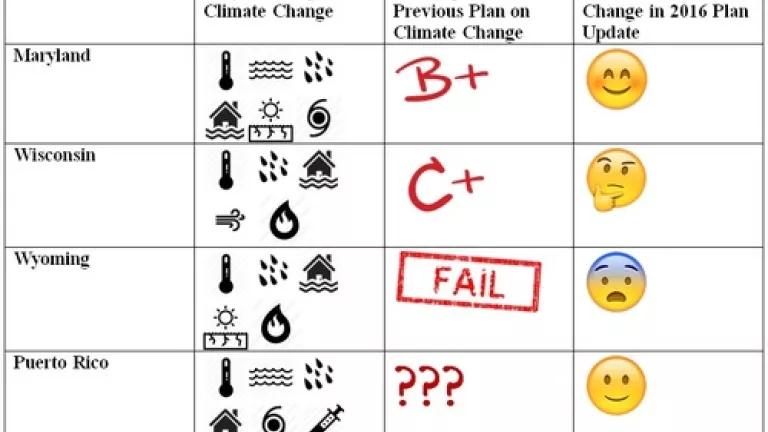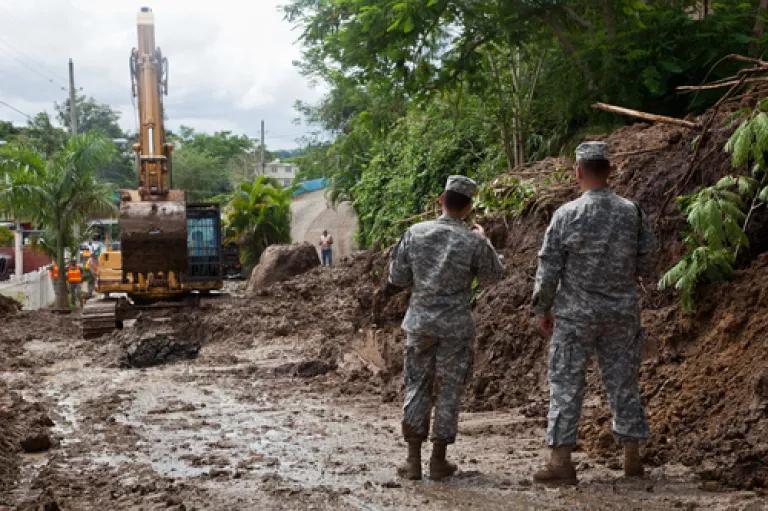Puerto Rico's 2016 Disaster Plan Update: Hard to Predict, But We See Positive Signs (Part 5 of 5)

As I previewed on Monday, this week we're taking an in-depth look at the four U.S. jurisdictions who are required to update their State Hazard Mitigation Plans in 2016 to account for the projected effects of climate change. On Monday we looked at Maryland, which we expect to develop one of the year's strongest plans. On Tuesday we checked out Wisconsin, where politics could interfere with state agency staff's intentions to strengthen their plan. Yesterday we turned our attention to Wyoming, where climate change has routinely been ignored. Today we're taking a look at Puerto Rico in our last installment of this weeklong series.
Deadline for Puerto Rico's plan update: September 2016
Projected climate change impacts:
- Puerto Rico is one of the most vulnerable places on Earth to the impacts of climate change. In Puerto Rico, approximately 419,000 people live within the coastal zone, and 2.3 million live within the island's 44 coastal municipalities. Nearly all of Puerto Rico's essential infrastructure is located on the coast, including the main international airport and all its thermoelectric plants.
- According to the Puerto Rico Climate Change Council, climate projections for extreme events show a probable increase in extreme heat days.
- The U.S. Army Corps of Engineers has estimated that sea levels could rise by 22 inches by 2060. According to the PRCCC, "It is no longer a question of whether the coasts of Puerto Rico and many port cities in the Caribbean will be inundated, but rather it is a question of when and by how much."
- Coastal erosion will continue to occur due to sea level rise, which is already being observed in parts of the island at rates of up to 3.3 feet per year.
- Regional downpours are likely to increase in frequency and intensity.
- In the Caribbean, diseases already present, including malaria and dengue and yellow fevers, could increase with warming temperatures.
- Finally, the IPCC climate simulations suggest that the Caribbean will experience a decrease in tropical cyclone frequency, but an increase in the frequency of the most intense events.

Damages to Puerto Rico after Hurricane Irene. Climate change could increase the frequency of the most intense storm events. Photo credit: FEMA.
Does the previous hazard mitigation plan take climate change into account?
GRADE: ???. Puerto Rico does not post its hazard mitigation plans online, and our request for a copy of the current plan received no response, so we don't know how well that plan accounts for the projected effects of climate change.
How much money is at stake?
Puerto Rico has received an enormous amount of money through FEMA's hazard mitigation grant programs: almost $300 million. This is more than any other jurisdictions updating their plans this year have received. The bulk of this funding - which is contingent upon Puerto Rico having an approved hazard mitigation plan - came in the form of one $190 million grant in 1999, which was used to rebuild homes damaged during Hurricane Georges, making them more resistant to future storms.
What can we expect from Puerto Rico in the 2016 plan?
Indications are good that Puerto Rico will consider climate change in its plan. The Puerto Rico Climate Change Council (PRCCC), a project of NOAA and the Puerto Rico Department of Natural and Environmental Resources, has developed reports assessing the projected effects of climate change on the island.
Last month, Puerto Rico's representatives to the Conference on Climate Change in the Caribbean signed a new Memorandum of Understanding on efforts to fight climate change, together with the U.S. federal government and the Virgin Islands. This MOU includes efforts to build resilience on the island by addressing issues like sea level rise and flooding. The governor, Alejandro Garcia Padilla, also recently signed a land-use plan for the island that will help prepare for the effects of climate change through conservation and regulation of development.
We hope that the Puerto Rico 2016 plan update includes a full assessment of climate risks and, critically, concrete mitigation strategies that can help this vulnerable island prepare for future natural hazards.
NRDC will be closely tracking the hazard mitigation plan update process in all four of these jurisdictions - Maryland, Wisconsin, Wyoming, and Puerto Rico - throughout the coming year. And, of course, we'll be pushing all four to include the most robust analysis possible of climate change projections in their plans. Thanks for joining us this week, and stay tuned!

